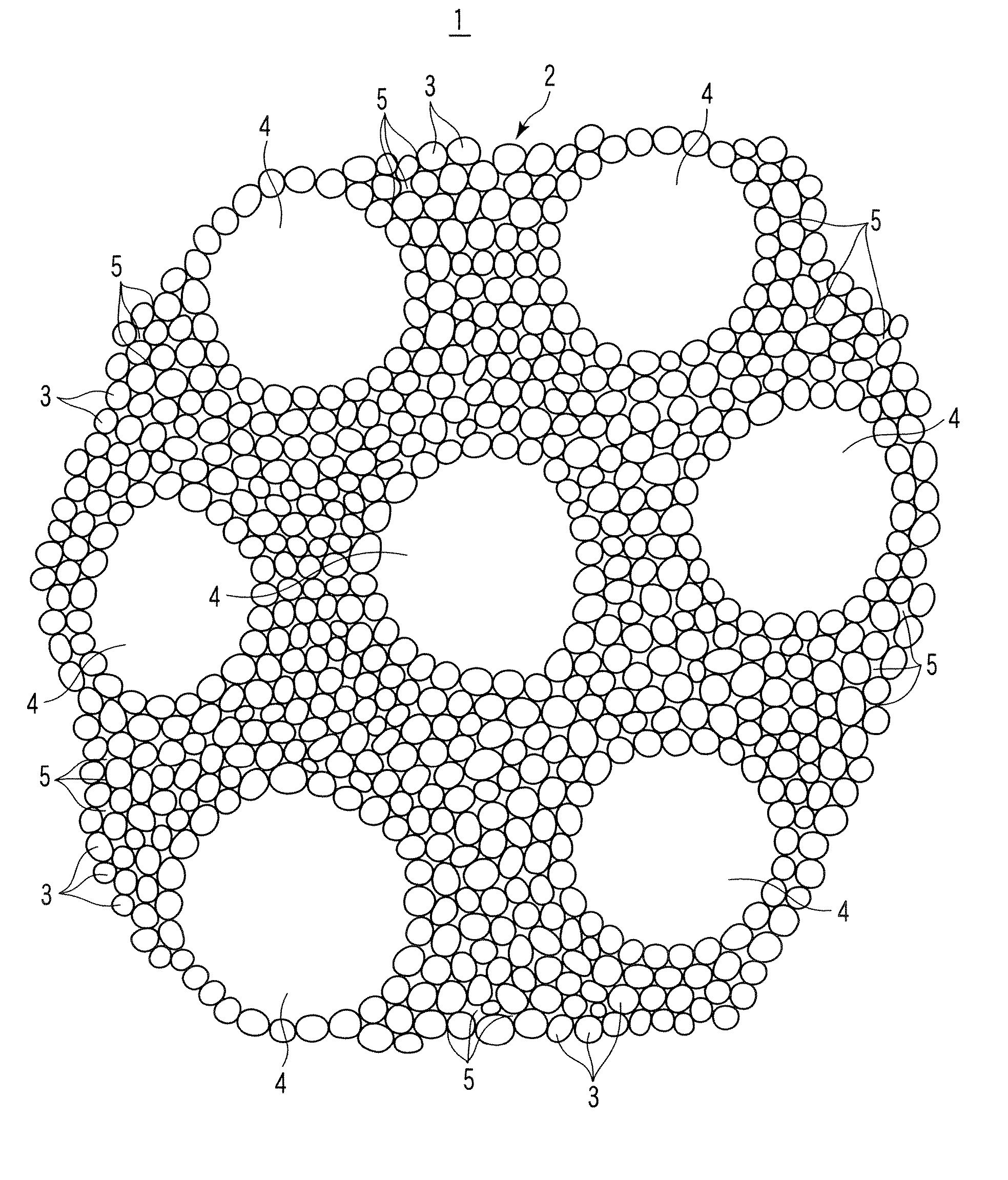Carbon dioxide absorbent and method of manufacturing carbon dioxide absorbent
a carbon dioxide and absorbent technology, applied in the field of carbon dioxide absorbent, can solve the problem of difficult to obtain the stable carbon dioxide desorption property for a long time, and achieve the effect of improving the stability of the carbon dioxide desorption property
- Summary
- Abstract
- Description
- Claims
- Application Information
AI Technical Summary
Problems solved by technology
Method used
Image
Examples
example 1
[0060] Silicon dioxide powder with an average particle diameter of 10 μm, lithium carbonate powder with an average particle diameter of 1 μm, and potassium carbonate powder with an average particle diameter of 1 μm were weighed to adjust their molar ratio at Li2CO3:SiO2:K2CO3=2:1:0.1. Fibrous lithium titanate powder with an average particle diameter of 0.5 μm and an average length of 15 μm in an amount of 10% by weight in the entire powder was added to the obtained powder mixture and the powder mixture was mixed while being milled by a ball mill to obtain a starting material powder mixture. Successively, the starting material powder mixture was heated at 900° C. for 8 hours in air atmosphere in a box type electric furnace, cooled, taken out of the furnace, crushed, and sieved to synthesize a lithium silicate powder with an average primary particle diameter of 3 μm and containing lithium titanate.
[0061] Next, the lithium silicate powder and spherical graphite powder with a diameter ...
example 2
[0063] Silicon dioxide powder with an average particle diameter of 10 μm, lithium carbonate powder with an average particle diameter of 1 μm, and potassium carbonate powder with an average particle diameter of 1 μm were weighed to adjust their molar ratio at Li2CO3:SiO2:K2CO3=2:1:0.1. Fibrous lithium titanate powder with an average particle diameter of 0.5 μm and an average length of 15 μm in an amount of 10% by weight in the entire powder was added to the obtained powder mixture and the powder mixture was mixed while being milled by a ball mill to obtain a starting material powder mixture. Successively, the starting material powder mixture was heated at 900° C. for 8 hours in air atmosphere in a box type electric furnace, cooled, taken out of the furnace, crushed, and sieved to synthesize a lithium silicate powder with an average primary particle diameter of 4 μm and containing lithium titanate.
[0064] Next, the lithium silicate powder and spherical graphite powder with a diameter ...
example 3
[0075] Silicon dioxide powder with an average particle diameter of 10 μm, lithium carbonate powder with an average particle diameter of 1 μm, and potassium carbonate powder with an average particle diameter of 1 μm were weighed to adjust their molar ratio at Li2CO3:SiO2:K2CO3=2:1:0.1. Fibrous lithium titanate powder with an average particle diameter of 0.5 μm and an average length of 15 μm in an amount of 10% by weight in the entire powder mixture was added to the obtained powder mixture and the powder mixture was mixed while being milled by a ball mill to obtain a starting material powder mixture. Successively, the starting material powder mixture was heated at 900° C. for 8 hours in air atmosphere in a box type electric furnace, cooled, taken out of the furnace, crushed, and sieved to synthesize a lithium silicate powder with an average primary particle diameter of 3 μm and containing lithium titanate.
[0076] Next, the lithium silicate powder and spherical graphite powder with a d...
PUM
| Property | Measurement | Unit |
|---|---|---|
| diameter | aaaaa | aaaaa |
| porosity | aaaaa | aaaaa |
| particle diameter | aaaaa | aaaaa |
Abstract
Description
Claims
Application Information
 Login to View More
Login to View More - R&D
- Intellectual Property
- Life Sciences
- Materials
- Tech Scout
- Unparalleled Data Quality
- Higher Quality Content
- 60% Fewer Hallucinations
Browse by: Latest US Patents, China's latest patents, Technical Efficacy Thesaurus, Application Domain, Technology Topic, Popular Technical Reports.
© 2025 PatSnap. All rights reserved.Legal|Privacy policy|Modern Slavery Act Transparency Statement|Sitemap|About US| Contact US: help@patsnap.com


